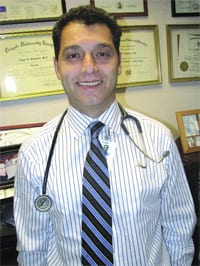Helping Women Find a Higher Quality of Life
Dr. Oz Harmanli says that it wasn’t so long ago that many women would have considered conditions such as urinary incontinence or pelvic organ prolapse — which occurs when vaginal support is lost, resulting in sagging or dropping of the bladder, uterus, and rectum — as simply a part of getting older or an aftereffect of pregnancy.
And they would learn to live with them.
Times are different, said Harmanli, and much of the reason why has to do with how current generations of women approach these medical issues. “We’re talking about the Baby Boom generation,” he explained, “and how its members generally don’t settle for things.”
And so, many more women facing these problems are instead committing themselves to living without them.
This sentiment explains why Harmanli, chief of Urogynecology and Pelvic Surgery at Baystate Urogynecology, and other members of his team — Dr. Keisha Jones and Eileen Bryson, RN — are much busier now than they were even a few years ago.
“The word is out,” he said, referring to procedures such as the one to correct female urinary incontinence. “Ten years ago, there were five of these procedures done a month; now, I do five a week.”
And these prevailing attitudes about such conditions explain the continued growth of Urogynecology, a relatively new field — it dates back to the late 70s — that is a subspecialty of gynecology.
Urogynecologists are gynecologists who complete additional years of training focused on the evaluation and treatment of pelvic organ prolapse, bladder-control problems, and similar conditions. The job description includes surgical procedures, most all of them minimally invasive, but also large amounts of awareness-building work when it comes to these conditions.
Practitioners must also be adept at getting women to talk about issues they generally don’t want to talk about, said Harmanli, adding that this is often difficult to do, even for a generation of women that is well informed and empowered to do something about their condition.
“It is hard to get some people to open up about these issues,” he said, adding that efforts to build awareness about these conditions and ways to treat them are hampered by the fact that these are topics still seen as mostly inappropriate for the mainstream media — although coverage is getting better, he said.
“It’s a sensitive area,” he said, noting that while incontinence may be safe subject matter, pelvic organ prolapse “isn’t something you can cover in the daily newspaper or local TV news.”
For this, the latest installment in its Today’s Physician series, Healthcare News talks with Harmanli, who emigrated from his native Turkey to the United States nearly 20 years ago, about his career, his specialty, and how it is evolving.
Coming to America
Harmanli, one of four children, said that his siblings all gravitated toward engineering while growing up in Turkey’s capital city, Ankara. And he was leaning in that direction as well.
“But my mother really wanted one of us to become a doctor,” he continued, adding that he eventually became the one. Upon completion of high school he went to the Hacettepe University School of Medicine in Ankara, where he completed his undergraduate and medical education in six years.
Harmanli said that it was his intent to come to the United States soon after graduating from medical school, but such a process is fairly complex, and often individuals come to this country without a job in hand. “I thought that would be an adventure,” he explained with a smile, “and at that time I was also making plans to get married. I got married, and I decided that one adventure was enough to start with.”
Thus, he stayed in Turkey and embarked on a residency in Obstetrics and Gynecology and board cedrtification at Dr. Z. T. Barak Women’s Hospital in Ankara.
Eventually, though, he did come to this country, and, more specifically, a transitional internship in General Surgery at Christina Care in Neward, Delaware. After returning to Turkey, and Dr. Z. T. Barak for a year, he came back to the United States for residencies at Thomas Jefferson University, Jefferson Medical College and Temple University School of Medicine, followed by a fellowship in Female Pelvic Medicine and Reconstructive Surgery at Temple.
Upon completion of his fellowship, he stayed on at Temple, working under his mentor in the Urogynecology Department. When his mentor took another position in New Jersey in 2000, Harmanli became director of that unit and remained in that position for four years.
Eventually, Harmanli started exploring other career opportunities, and found exactly what he was looking for at Baystate Urogynecology — specifically, a large service area (it’s the only department of its kind west of Worcester), and thus huge growth potential.
When asked about a day, or week, in the life of a urogynecologist, Harmanli said his practice blends aspects of Urology and general surgery. It’s a combination he finds enjoyable and rewarding.
Elaborating, he said that those in his field are treating conditions that, while rarely, if ever, life-threatening, greatly impact a woman’s quality of life and self-esteem. And the volume of such work is greater than many people would think.
“Pelvic organ prolapse effects 30{06cf2b9696b159f874511d23dbc893eb1ac83014175ed30550cfff22781411e5} to 40{06cf2b9696b159f874511d23dbc893eb1ac83014175ed30550cfff22781411e5} of the women who have given birth,” he said, adding that only about 8{06cf2b9696b159f874511d23dbc893eb1ac83014175ed30550cfff22781411e5} of women will have what’s considered advanced cases that require surgery. “Every year, 200,000 procedures are done to repair pelvic organ prolapse; that’s higher than the number of bypass surgeries done in this country in a year.
“This is a hidden epidemic with the aging population that we have,” he continued, noting that the vast majority of his patients are over age 50, but some are considerably younger. “These are Baby Boomers, they’re quite well-educated, and they want to have everything better.”
The field of urogynecology has benefited greatly from advancing technology, said Harmanli, especially in the realm of minimally invasive surgery and use of robots such as the da Vinci Surgical System.
“Many of our procedures are streamlined; we have a procedure to correct female urinary incontinence that takes less than 30 minutes to do, there’s the tiniest of incisions, and they go home the same day,” he explained. “Before, maybe 10 years ago, there used to be an open incision, several days in the hospital recovering, and then maybe a couple of weeks of catheterization.”
The quick recovery times and improvement in quality of life often create what Harmanli called “great advertisements” for the services of his department, as women tell others about their experiences, prompting them to become proactive about seeking solutions to their problems.
“Years ago, women would say of these conditions, ‘oh, it’s just part of getting older after having babies; it’s a natural process we have to deal with,’” said Harmanli. “Not anymore, because these generations want more, and now, there is more.”
Drawing to a Close
When he’s not working, Harmanli spends a lot of time with his family, and especially his two children. He plays soccer — the sport is very popular in Turkey — and likes drawing, specifically cartoons.
He’s created a few designed to help in his efforts to build awareness of the conditions he treats, sketches that make use of humor to get various points across.
Overall, his work generates smiles from women who, unlike those in generations that preceded them, don’t have to live with things like incontinence.



Comments are closed.